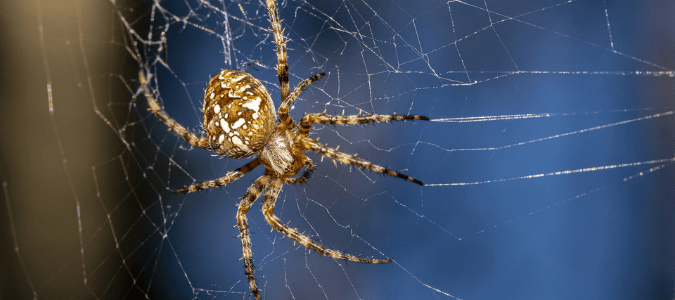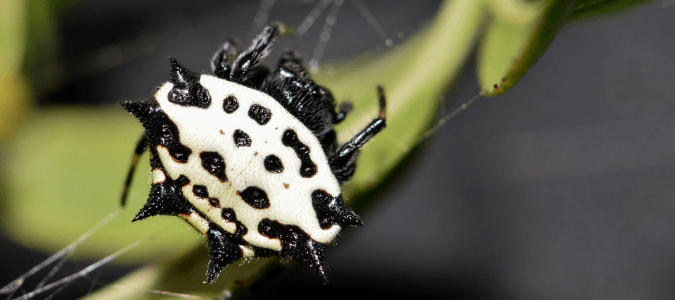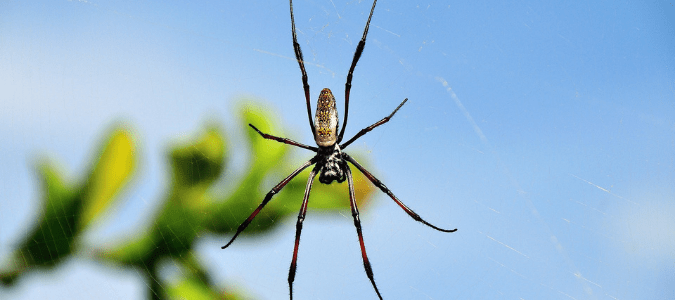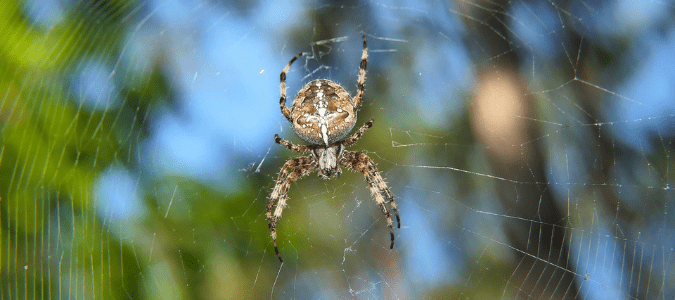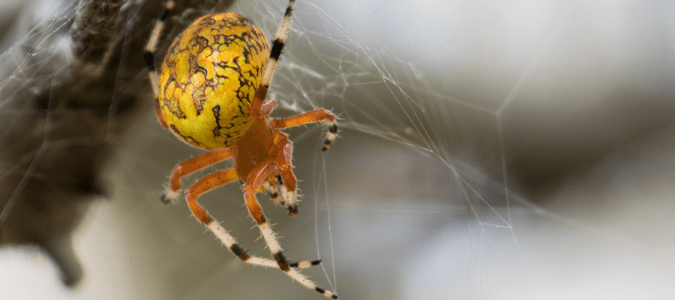Orb weavers are a group of spiders that includes many different species. However, each of these spiders shares certain characteristics.
For one, they spin intricate webs using both sticky and non-sticky silk. In fact, orb weaver spiders even got their name from the shape of their webs because they weave organized webs that are circular like orbs. They use the non-sticky silk to build the frame of their web. They also use it for the threads that anchor the web to trees and plant stems, as well as the radial support threads of the structure.
The spiders then use sticky silk to spin a circular pattern between these support threads. They also use these sticky threads to catch prey. Additionally, many kinds of orb weavers build a thick, zig-zag line from the center of the web downward known as a “stabilimentum.” It is believed that this part of the web helps attract prey.
All kinds of orb weavers generally have eight eyes and large spherical abdomens. However, different species come in a range of colors and have a wide variety of patterns on their bodies.
Spiny Orb Weaver
Spiny orb weaver spiders are one of the smallest types of orb weavers. Females are just about a half inch long, while males are less than an eighth of an inch in length. Despite their size, these critters can spin webs as big as 12 inches wide.
Like other spiders in this group, they build flat, round webs, typically in trees or shrubs. These critters do not usually come indoors, but they might build webs in the corners of outdoor areas of buildings, such along a window frame. Each female spiny orb weaver spider builds and lives on its web, while male spiders hang out on a single thread near the female spiders’ webs.
Beyond their size, spiny orb weavers are also recognizable by their shape and color. Their broad abdomens have six pointy spines coming out of the side, which makes them look like crabs. Their bodies are typically white, yellow or orange with red markings, and they have black legs.
Spiny orb weavers can be found in many parts of the southern United States, especially in shrubby gardens, citrus groves or on the edge of woodlands. Because of their shape, they are sometimes called crab-like orbweavers or spinybacked orbweavers. These critters can be beneficial to have in the garden since they feed on pests like mosquitoes, wasps, flies and small beetles.
Unfortunately, these cool-looking creatures have a short lifespan. The male spiders die just six days after mating and the females die soon after. Female spiny orb weavers produce an egg sac with between 100 and 260 eggs.
The mother deposits the egg case on the underside of a leaf and covers it with a tangle of white, yellowish and green silk threads to protect the eggs. She then dies shortly after laying the egg case. The eggs hatch around eleven to thirteen days later. However, the babies stay in the case for about two to five weeks until they are mature enough to venture into the outside world.
Golden Silk Orb Weaver Spider
Golden silk orb weavers are one of the largest types of orb weaver spiders in the United States. The females can grow as big as three inches in length, and males can get about an inch big. Their webs are also huge. The average size is about two feet wide, but these spiders can build webs that are as large as six feet in diameter.
One of the most unique things about golden silk orb weaver spiders is that the silk they produce to build their webs is yellow and can look golden in the sun. Beyond being colorful, their silk is also unusually strong. Some studies have even shown that it might be stronger than Kevlar.
These spiders mostly get their name from the color of their webs instead of the color of their bodies. Females have long cylindrical abdomens that are tan or dull orange and have yellow spots. They have two shorter legs and six long, skinny legs that are orange and brown banded with bunches of dark-colored hair near the segments. On the other hand, males are slender and dark brown.
They typically spin their strong, intricate webs between trees or shrubs in open woods or on the edges of forests. These are often the kinds of spider webs that you might walk into when you are hiking, biking or hunting. They are also commonly found in pecan and citrus groves. Gold silk orb weavers live in warm, humid areas across the southern United States. They typically come out between the mid-summer and late fall.
These critters are sometimes also called golden silk spiders or banana spiders. However, they should not be confused with the deadly varieties of banana spiders found in and around Brazil. Although golden silk orb weaver spiders might bite if you bother them, their bites are mostly harmless to humans. These yellow garden spiders prefer to feed on insects like wasps, bees, grasshoppers, mosquitoes, butterflies, moths and flies.
Cross Orb Weaver Spider
Female cross orb weaver spiders are brown to yellow colored. They have two wavy lines along their bodies and multiple yellow or white spots around or inside the lines. Near the end of their abdomen, they also have four long spots that create what can look like a cross. This is how this spider gets its name. Their legs are tan and brown-banded, and they have short hairs on them. These are a smaller type of orb spider. Females are just a quarter of an inch to about three quarters of an inch long. Males are typically less than a quarter of an inch to around a half of an inch long.
Cross orb weaver spiders are also sometimes called European garden spiders. This critter likely came over from northern Europe. In the United States, these spiders are mostly found in northern states and up into Canada. They build their webs on or next to buildings, especially structures that have exterior lights. These lights help them attract prey. You can also find them in gardens or agricultural fields. They come out in late summer through the fall.
These spiders lay between 300 to 900 eggs at a time. They enclose the eggs in a yellowish egg case, which they deposit in crevices or under the bark of dead trees to protect their young. They also use their silk to build orblike webs that can be as big as 15 inches in diameter. Female cross orb weavers spend their time in their webs and use it to trap prey. They eat a range of small flying insects. When they feel threatened, they might sit in the middle of the web and shake it to scare away potential threats.
Cross orb weavers do not usually bite people unless you grab or corner them. Their bites can be painful, but the pain and any redness or swelling usually goes away quickly. Although these bites are generally harmless, some people experience more serious symptoms. Cross orb weaver bites can lead to headaches, nausea and muscle cramps.
Marbled Orb Weaver Spider
Marbled orb weaver spiders are found throughout many parts of the United States. They typically live along the banks of streams, as well as in tall weeds, grass, trees and shrubs in moist wooded areas. They sometimes also show up in urban areas and build webs on manmade structures like mailboxes.
These colorful spiders are sometimes also called pumpkin spiders because of their brightly colored and marbled markings. They have large abdomens that are typically orange with pale yellow spots and purple or brown markings. However, they sometimes have abdomens that are almost white, grayish or tan. Their head and thorax are burnt orange with dark lines.
These spiders have multicolored legs that are orange near the body, yellow in the middle and brown at the tips. The female grows to about a quarter of an inch to three quarters of an inch long, while the male is usually less than half an inch long.
Unlike many other kinds of orb weaver spiders, marbled orb weavers do not live in their webs. Instead, they hide to the side of the web and use a “signal thread” attached to the center of their web to figure out they have trapped prey in their web. They do not usually bite people unless you threaten their eggs, and even then, their bite is typically harmless for humans.
Orb Weavers and Other Pests
For the most part, orb weavers are harmless to people. They can bite, but this usually is not dangerous for humans. In fact, these spiders are typically more beneficial than they are harmful because they eat a range of insects.
However, if you have orb weaver spiders on your property, this might be a sign that other pests are present as well. Whether you feel uncomfortable with the spiders or are nervous about the possibility of pest populations in or around your home, you can reach out to a pest control professional for help. They an create a pest control plan or spider control plan.
ABC Can Help With Garden Pests
A spike in orb weaver populations on your property can make you understandably nervous. ABC Home & Commercial Services can determine why these spiders are attracted to your property. Furthermore, we can treat any pests that are attracting spiders.
